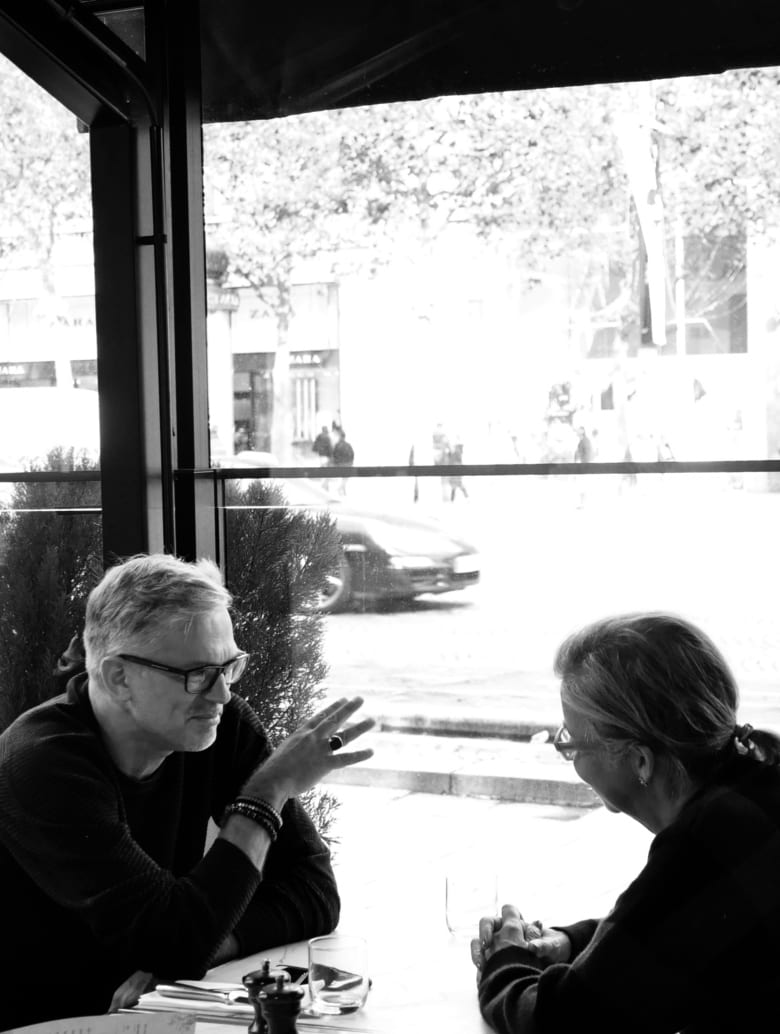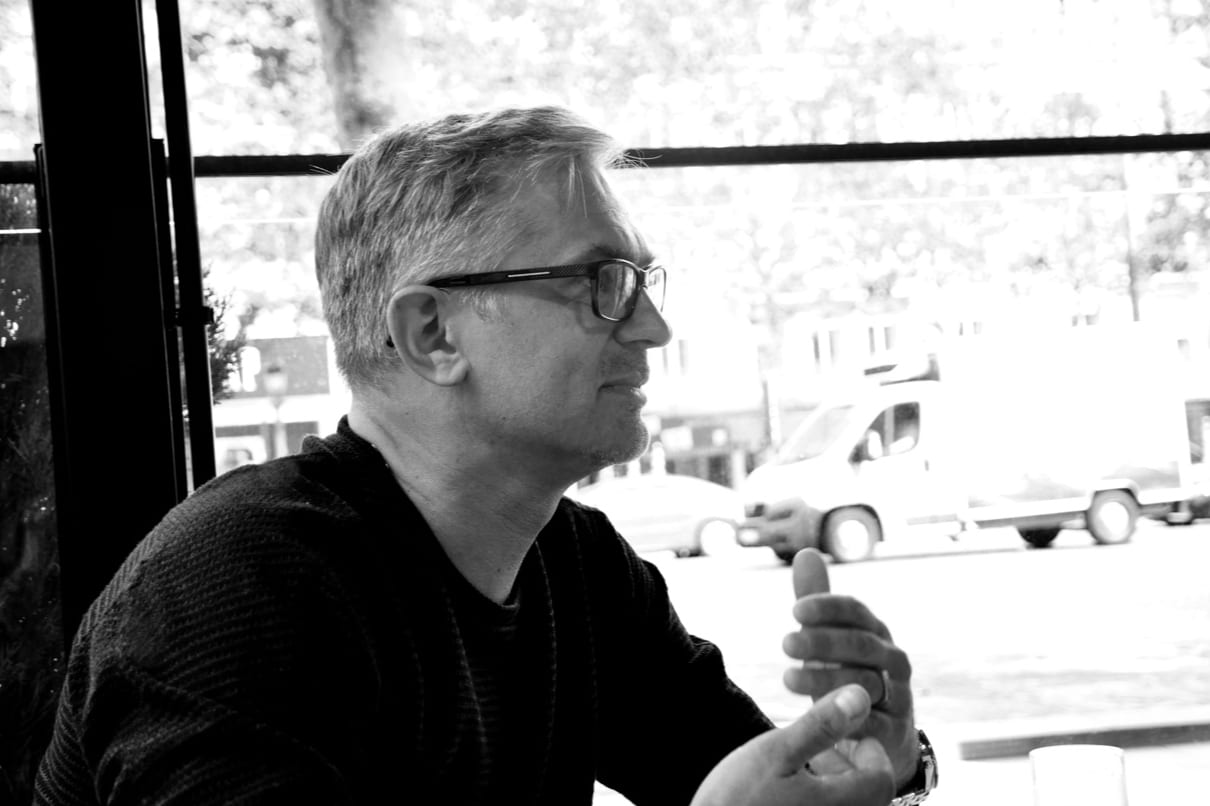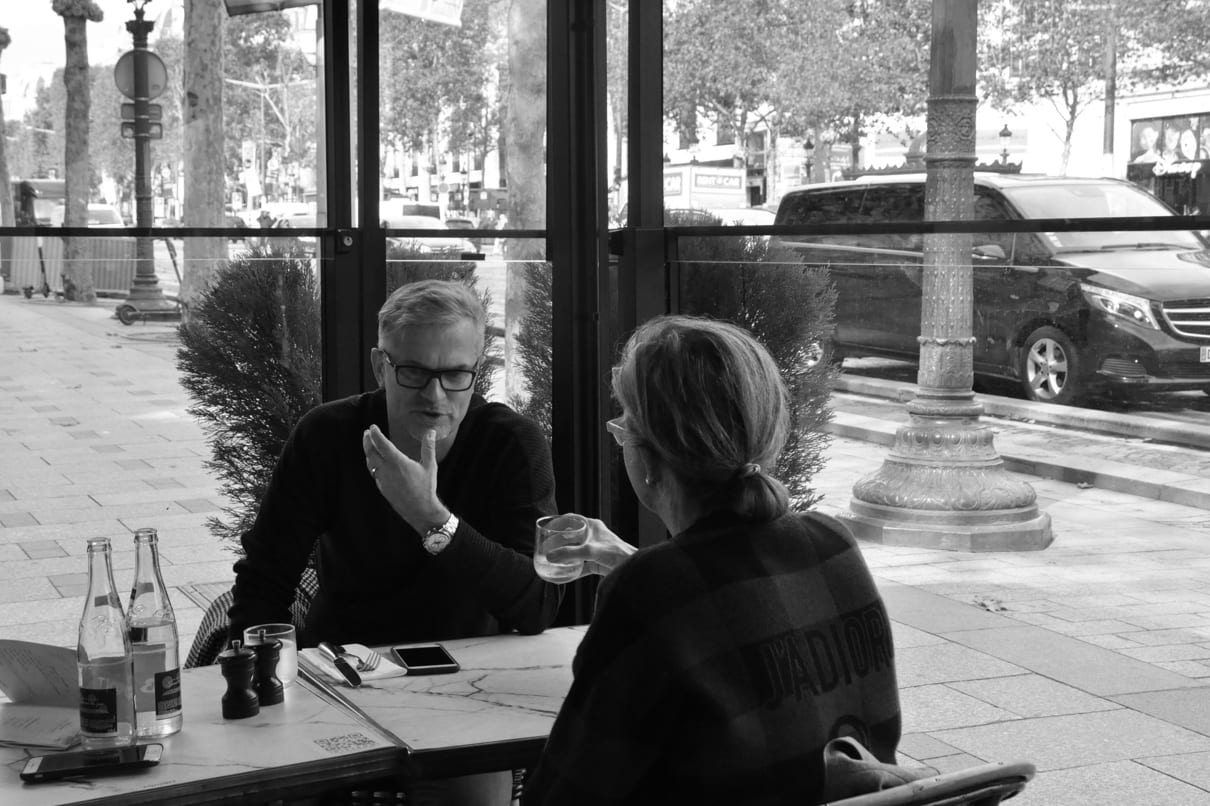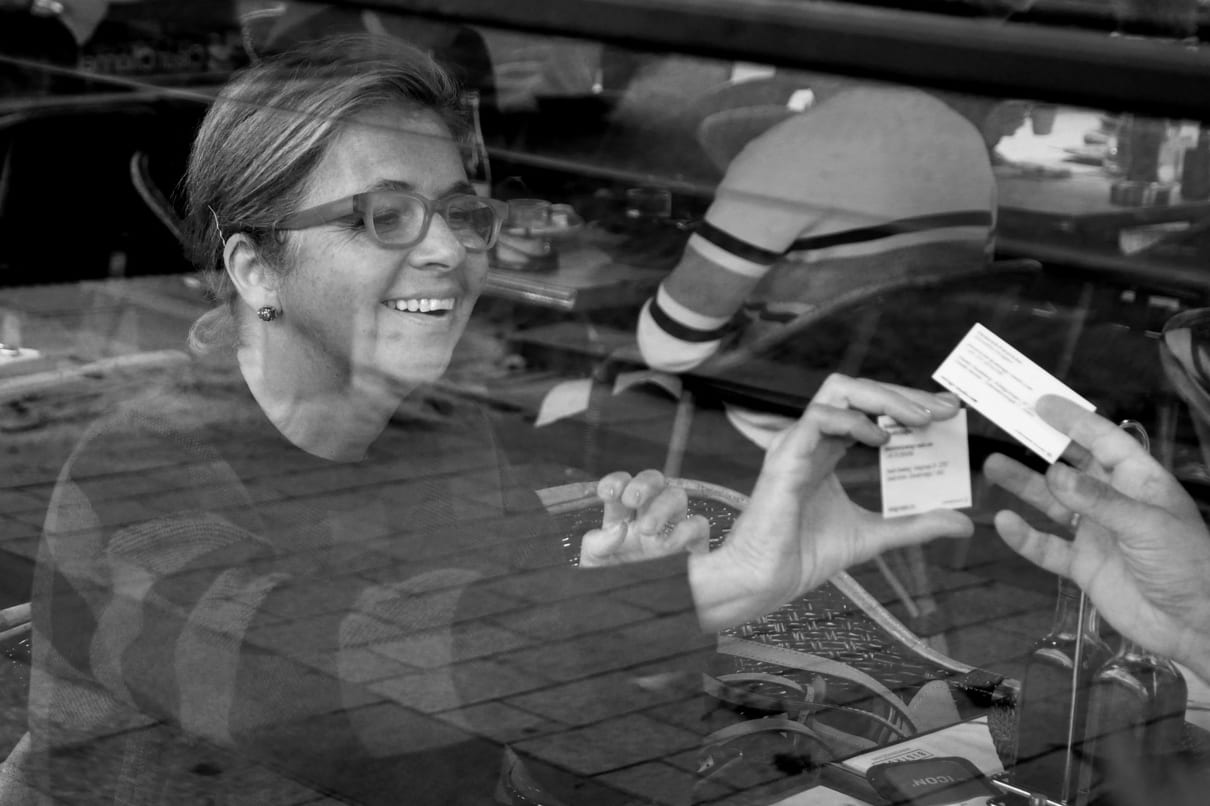Interview with Heinrich Paravicini by Inga Griese
The usual fashion-week chaos reigns in L’Avenue on Avenue Montaigne. The restaurant, which is the place to be seen and discovered, resembles the backstage area shortly before a big fashion show – a bustling hullabaloo. It is the wrong time and place for a good conversation. We leave the table and take a walk to the Champs-Élysées, where we take a seat in a restaurant pavilion on the pavement with a view of the hustle and bustle of the city that Heinrich Paravicini loves so much. The timing is also perfect. We have barely finished our food and discussion when construction workers begin to tear up the road right in front of our table. A good omen if ever there was one.
Heinrich, we are meeting here because you have plans that have a lot to do with Paris. Don’t you like it in Hamburg anymore?
I have been there for over 20 years now. Ever since I founded our design company Mutabor with Johannes Plass. I really like Hamburg; it’s a city with a great quality of life. But it is just not so inspiring. Paris is on another level in that regard and is also my home.
You grew up here, didn’t you?
Yes. My parents lived here for 30 years. My father was Director of the German Historical Institute here in Paris. We did move a lot, but the longest period was spent in a great flat in Place des Vosges in Marais. That is the place I see as my ‘home’, so to speak. Back then, in the early nineties, it was not as touristy as it is now. I remember eating at Jo Goldenberg’s place in Rue des Rosiers ... and the delicious pastries at Florence Finkelsteyn’s. Almost all the old Jewish-run shops are gone now. There are only boutiques and masses of people here now.
But in the nineties I spent most of my time studying at Muthesius Academy in Kiel, anyway.
Quite the contrast.
Paris and Kiel. Yes, that’s true! But all in all it was not so bad, because that is how I got to know my business partner and friend Johannes. That is how Mutabor came into being – and now it is the most creative design agency in Germany and also one of the largest owner-managed ones. But: sooner or later, it is always time for something new. Like Mirage! But that doesn’t mean I am leaving Mutabor. Mirage is a wholly owned subsidiary. But I will take care of it personally.

»Mirage represents visual fascination.«
‘Mirage’, like the casino in Las Vegas?
Although now common in English, mirage is originally a French term for what is also referred to as a Fata Morgana. That is why there is the Mirage Casino in the desert, where Siegfried and Roy did their Las Vegas shows. But that is not where the name comes from. When I was going to school here in Paris back in the eighties and would run riot along the boulevards, I built many models of a Dassault fighter jet called Mirage. It had such a unique, delta wing design. That fascinated me.
At some point, I wondered: ‘What does Mirage actually mean?’ – because I liked the name so much. And when I got started with my new project, I remembered the word. And the connection to Fata Morgana, when you are crawling through the Sahara, dying of thirst and suddenly discover an oasis that is not actually there. It is only a visual fascination. That seemed appropriate to me. And it had to be something French, too. It was important to me that our URL should also work in France. That way, I can also force myself to come back some time.
And what exactly do you want to capture with your fighter jet?
(Laughs) No, not a fighter jet. I am a pacifist and was also a conscientious objector. Above all, I want to focus on lifestyle and fashion customers again. Customers that we don’t speak to with Mutabor in the same way that we might have done ten years ago.
Are you automotive specialists at Mutabor?
We do a lot of automotive, a lot of industry and we have many major clients. Companies of the calibre of Siemens, Bosch, Audi, VW, Porsche and Vodafone. Given that we now have 150 people, we have also grown considerably. For me, the logical consequence of that was that at some point I had to change from being a designer to a design manager. And that is exactly the point: I want to work as a designer myself again.
And fashion and design is a more suitable area for that? And Paris, because in Germany there is still not enough clientele and recognition of the genre?
My area is brand design, i.e. brand development. However, brands in the fashion world only work together in small teams, which is very different to automotive companies, for example. Most have an in-house creative director, do their own shoots, are fully set up and thus have no need for a big external agency – except perhaps for PR or events. In other words, what I want to do is something very personal. I work in the team. I have no need for the ‘ballast’ of a big agency in that context. And I just love fashion and design.

»What I want to do is something very personal.«
How should we imagine that in practical terms? Let’s say there is the fashion customer XY, do you advise them on how they should set up their brand?
I am a graphic designer by nature and I also see myself as something of a craftsman, although, of course, I like to think I now offer a lot of strategic intelligence. I am not a tailor or a stylist, but I have over 20 years of experience with brands. And nowadays, due to the digital transformation and the whole topic of social media, fashion brands also need to change. They cannot make the mistake of just believing the stylists and bloggers, otherwise the lines between the brands will become too blurred. Particularly when you are releasing two to twelve collections a year, the brand is a very precious asset that you must handle extremely carefully. All in all, the mechanisms for a car manufacturer, tourism business or fashion brand are not really that different when it comes to the brand. All brands need a clear identity, an attitude and recognisable codes. That means I can put the know-how I bring with me to very good use: how to develop a brand and give it the right tools to still work internationally in future. The purely craft-based elements are also important: what does a logo have to look like to be optimally applicable on social media? How do I have to handle the codes of a brand so that people post the right photos, and so on? That requires a strategy and does not work in the short term.
So it is more of a digital approach?
Yes. A fashion brand must always be considered from a digital-first point of view these days. Or even: Instagram first.
And why fashion? Why not furniture? Or watches?
Simply because fashion interests me personally.

»Fashion brands can’t just believe in the stylists and bloggers.«
Is that the French conditioning?
Yes, on the one hand there is, of course, the fact that I grew up here and Paris has always been a source of inspiration for me. By which I don’t just mean the fashion, but also the museums, the whole city, all the multiculturalism, which, by the way, has developed in a strong and positive way again in the last five years.
Paris never really let me go; I am here every year and it is part of me. What’s more, I see today as something of a second chance. After all, after my studies I wanted to do something other than start a big agency: I wanted to become a fashion art director and even received a scholarship for Saint Martins in London. I was very much inspired by Nick Knight and Alexander McQueen at the time and desperately wanted to go there. And I was accepted. Then fate got in the way: an accident. In 1997 I was struck by lightning at the Grand Canyon in the USA. It was a miracle that I survived, but I had to spend a long time in recovery.
What a dramatic story!
I was lucky. I went flying through the air a few times, suffered burns and cardiac arrest. A great person who happened to be there and later became a good friend resuscitated me. It was an incredibly close shave. And it was destiny: due to that accident I missed the first term in London and Johannes said: ‘Come on, if you have to stay here, we can do some projects together.’ The rest is history: I never went to London, and instead I have 21 years in a design agency behind me. With Mirage, I am effectively returning to my passion for fashion. Thankfully, I can afford to give myself a bit of freedom. Mutabor is really going well, so I don’t immediately need to worry about going into the red, but can focus on doing what I do best. I’m looking forward to it.
Are you a one-man show?
I have a small team. Deliberately so: I always want to stay in single figures. A maximum of nine people. Each one will have a special skill. So far I have one employee who specialises in project management and social media, but can also produce fashion shows. The other is a great graphic artist, and another will be the fashion art director for shoots. Each one will contribute their special ability.
In Hamburg or in Paris?
We are starting in Hamburg and Berlin – I still have a suitcase there, you see. It’s not like I need to rent some offices by the Seine straight away. One thing at a time. But the destination is clear: I need to get here. It’s all very exciting.

»A lightning strike was my destiny.«
How long are you giving yourself?
Two years.
And by then it needs to be working?
Yes, by the time I’m 50, it needs to be working. But the team, that is to say, the three people starting it with me, are considerably younger and extremely motivated. I know it’s going to be a lot of fun.
Why should someone come to you?
Haha, it’s clear that no one was exactly waiting for me in this conglomerate of fashion and lifestyle. But I think a view from the outside, from someone who hasn’t been involved in this fashion circus for years, is helpful. When it comes to brands, I bring 20 years of experience and hundreds of design prizes. That can’t hurt. And it’s not like I am coming into contact with fashion and lifestyle for the first time. My CV includes 12 years of adidas, and customers like Baldessarini, Iris v Arnim and Condé Nast, after all.
In international fashion, a few Groups have bundled together lots of brands and there are fewer and fewer independent brands. Do you have a preference in that regard?
I like to focus on people. Specifically, people who stand for something and want to make something happen – good people, male or female.Whether they are working at a big company or own their own label really makes no difference. That is something I have learned in the last 20 years. The brand has to be the responsibility of the boss or top-level decision makers.
If the subject of the brand is left to the employee in the back corner of the Marketing department, the brand will never be successful.
Only great people make great brands. They are the ones I want to talk to.
What is your brand core?
Let me think ... I would say empathy for brands – and all their effects on communication: interior architecture, retail, images, relationships and human presence. I think I’m not bad at all that. And I am very quick – that is a big advantage. Fashion is a very fast-moving business where you can’t afford to wait six months to get through processes and interviews and then gradually move to the creation phase on the basis of a marketing strategy. You have to deliver quickly. And Mirage can do that.

»Only great people make great brands. They are the ones I want to talk to.«
And which clients have you convinced so far?
My first clients are very varied. I don’t want to name names yet, but one is a well-known Hamburg fashion company. The task there is to establish a new women’s outer garments fashion brand. Another is an internationally active family company that wants to get one of its brands back on track with the right story. A third project is a new agency for people management and influencer marketing. So they are very different subject areas and scales. One is almost on corporation level, the other in collaboration with the owner, and the third almost like a start-up.
What language do you dream in?
In the past my French was better than my German, but it has dropped off a lot since my parents moved back to Germany ten years ago. In 2006, for example, my father was accepted into the Académie française and I had to spend the evening discussing European policy with French dignitaries in their native tongue. I wouldn’t dare do that now. That is another reason for me to come back here. On vera bien!
The road workers start up the machines next to us. It sounds like a jet taking off.
This interview was conducted by Inga Griese, Editor-in-chief of ICON/ICONIST and Senior Editor of Style WELT in Paris.

»Mirage represents visual fascination.«

»What I want to do is something very personal.«
»Fashion brands can’t just believe in the stylists and bloggers.«

»A lightning strike was my destiny.«


»Only great people make great brands. They are the ones I want to talk to.«
Contact
Mirage
Studio Berlin
Schröderstraße 7
10115 Berlin
Team up with us
We’re always looking for top talent to join our team of designers, producers, writers, photographers, set designers, etc. We look for in-house and remote freelance talent. Email us at salut@mirage-studio.com with your website URL and a short description of who you are and why you’d like to join the team.
